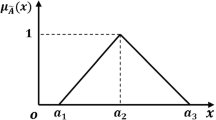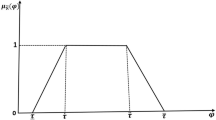Abstract
Multi-objective linear fractional programming (MOLFP) is an important field of research. As in several real-world problems, the decision-makers (DMs) need to find a solution to a MOLFP. In making a decision, the DM needs to deal with several imprecise numerical quantities due to fluctuating environments. This work presents a novel fuzzy multi-objective linear fractional programming (FMOLFP) model in an ambiguous environment. Since fuzzy set theory has been shown to be a useful tool to handle decisive parameters’ uncertain nature in several research articles. The proposed model attempts to minimize multiple conflicting objectives, simultaneously having some uncertain/fuzzy parameters. An equivalent crisp MOLFP model has been derived using the arithmetic operations on fuzzy numbers. After that, applying the Charnes-Cooper transformation effectively, the problem reduces to a deterministic multi-objective linear programming (MOLP). The MOLP is scalarized by using Gamma-connective and minimum bounded sum operator techniques to solve to optimality. The proposed algorithm’s computation phase’s basic idea is to transform the FMOLFP into a deterministic MOLP. Then to scalarize the MOLP into a single objective linear problem (LP) to optimize further. Later, the proposed model is applied to solve an integrated production-transportation problem.





Similar content being viewed by others
References
Achary S, Belay B, Mishra R (2019) Multi-objective probabilistic fractional programming problem involving two parameters Cauchy Distribution. Math Modelling Anal 24(3):385–403
Ahmad F, Alnowibet KA, Alrasheedi AF, Adhami AY (2021) A multi-objective model for optimizing the socio-economic performance of a pharmaceutical supply chain. Socio-Economic Planning Sciences. https://doi.org/10.1016/j.seps.2021.101126
Aliev RA, Fazlollahi B, Guirimov BG, Aliev RR (2007) Fuzzy-genetic approach to aggregate production-distribution planning in supply chain management. Inform Sci 177:4241–4255
Alves MJ, Climaco J (2007) A review of interactive methods for multiobjective integer and mixed-integer programming. Euro J Oper Res 180:99–115
Avci MG, Selim H (2018) A multi-objective simulation-based optimization approach for inventory replenishment problem with premium freights in convergent supply chains. Omega 80:153–165
Bellman RE, Zadeh LA (1970) Decision making in a fuzzy environment. Manag Sci 17:B141–B164
Campos L, Munoz A (1989) A subjective approach for ranking fuzzy numbers. Fuzzy Sets Syst 29:145–153
Chakraborty M, Gupta S (2002) Fuzzy mathematical programming for multiobjective linear fractional programming problem. Fuzzy Sets Syst 125(3):335–342
Charnes A, Cooper WW (1962) Programming with linear fractional functionals. Naval Res Logistics 9:181–190
Charnes A, Cooper WW (1977) Goal programming and multiple objective optimization. European Journal of Operational Research 1(1):39–54
Costa JP (2005) An interactive method for multiple objective linear fractional programming problems. OR Spectrum 27:633–652
Dash PDP, Dash RB (2012) Solving multi objective fuzzy fractional programming problem. Ultra Scientist 24(3):429–434
Fortemps P, Roubens F (1996) Ranking and defuzzification methods based on area compensation. Fuzzy Sets Syst 82:319–330
Ignizio JP (1983) Generalized goal programming: an overview. Comput Oper Res 10(4):277–289
Lai YJ, Hwang CL (1994) Fuzzy multiple objective decision making. Methods and Applications, Springer, Berlin
Leberling H (1981) On finding compromise solution in multicriteria problems using the fuzzy min-operator. Fuzzy Sets Syst 6(2):105–118
Li Z, Xiao S, Ge SS, Su H (2016) Constrained multilegged robot system modeling and fuzzy control with uncertain kinematics and dynamics incorporating foot force optimization. IEEE Trans Syst Man Cybernatics Syst 46(1):1–15
Li XQ, Zhang B, Li H (2006) Computing efficient solutions to fuzzy multiple objective linear programming problems. Fuzzy Sets Syst 157:1328–1332
Liang TF (2008) Integrating production-transportation planning decision with fuzzy multiple goals in supply chains. Int J Production Res 46(6):1477–1494
Liou TS, Wang MJ (1992) Ranking fuzzy numbers with integral value. Fuzzy Sets Syst 50:247–255
Luhandjula MK (1984) Fuzzy approaches for multiple objective linear fractional optimization. Fuzzy Sets Syst 13:11–23
Luhandjula MK (2015) An interval approximation approach for multiobjective programming model with fuzzy objective functions. Int J Uncertainty Fuzziness Knowl-Base Syst 23(6):845–860
Moitra BN, Maulik U, Pal BB (2003) A goal programming procedure for fuzzy multiobjective linear fractional programming problem. Fuzzy Sets Syst 139:395–405
Moreira FN, Lobo BA, Cordeau JF, Guimaraes L, Jans R (2018) Solving a large multi-product production-Routing problem with delivery time windows. Omega. https://doi.org/10.1016/j.omega.2018.07.006
Mula J, Peidro D, Diaz-Madronero M, Vicens E (2010) Mathematical programming models for supply chain production and transport planning. Euro J Oper Res 204:377–390
Nishizaki I, Uemura Y, Sakawa M (2000) Interactive fuzzy programming for twolevel linear fractional programming problems with fuzzy parameters. Fuzzy Sets Syst 115:93–103
Pramanik S, Dey PP (2011) A priority based fuzzy goal programming to multi-objective linear fractional programming problem. Int J Comput Appl 30(10):1–6
Priyan S, Uthaykumar R (2014) Optimal inventory management strategies for pharmaceutical company and hosital supply chain in a fuzzy-stochastic environment. Oper Res Health Care 3:177–190
Sakawa M, Yano H (1985) Interactive decision making for multi-objective linear fractional programming problems with fuzzy parameters. Cybernet Syst 16:377–394
Shavazipour B, Lopez-Ibanez M, Miettinen K (2021) Visualizations for decision support in scenario-based multiobjective optimization. Inform Sci 578:1–21
Singh SK, Yadav SP (2015) Modeling and optimization of multi objective non-linear programming problem in intuitionistic fuzzy environment. Appl Math Modell 39:4617–4629
Singh SK, Yadav SP (2015) Fuzzy programming approach for solving intuitionistic fuzzy linear fractional programming problem. Int J Fuzzy Syst 18(2):263–269
Singh SK, Goh M (2018) Multi-objective mixed integer programming and an application in a pharmaceutical supply chain. International Journal of Production Research. https://doi.org/10.1080/00207543.2018.1504172
Swarup K (1965) Oper Res 12:1029–1036
Takagi T, Sugeno M (1985) Fuzzy identification of Systems and its applications to modeling and control. IEEE Trans Syst Man Cybernat Syst 15(1):116–132
Tong S, Zhang L, Li Y (2016) Observed-based adaptive fuzzy decentralized tracking control for switched uncertain non-linear large-scale systems with dead zones. IEEE Transa Syst Man Cybernat Syst 46(1):37–47
Torabi SA, Hassini E (2008) An interactive possibilistic programming approach for multiple objective supply chain master planning. Fuzzy Sets Syst 159:193–214
Zhang J, Xiang J, Cheng TCE, Hua G, Chen C (2018) An optimal efficient multi-attribute auction for transportation procurement with carriers having multi-unit supplies. Omega. https://doi.org/10.1016/j.omega.2018.06.010
Zheng JN, Chien CF, Wu JZ (2018) Multi-objective demand fulfillment problem for solar cell industry. Comput Ind Eng 125:688–694
Zimmermann HJ (1978) Fuzzy programming and linear programming with several objective functions. Fuzzy Sets Syst 1:45–55
Zionts S (1968) Programming with linear fractional functionals. Naval Res Logistics 15:449–451
Zionts S, Wallenius J (1976) An interactive programming method for solving the multiple criteria problem. Manag Sci 22(6):652–663
Author information
Authors and Affiliations
Ethics declarations
Conflict of interest
Authors have no any conflict of interest of any form.
Additional information
Communicated by Anibal Tavares de Azevedo.
Publisher's Note
Springer Nature remains neutral with regard to jurisdictional claims in published maps and institutional affiliations.
Rights and permissions
About this article
Cite this article
Singh, S.K., Yadav, S.P. Scalarizing fuzzy multi-objective linear fractional programming with application. Comp. Appl. Math. 41, 93 (2022). https://doi.org/10.1007/s40314-022-01798-2
Received:
Revised:
Accepted:
Published:
DOI: https://doi.org/10.1007/s40314-022-01798-2
Keywords
- Fractional programming
- Multi-objective optimization
- Triangular fuzzy number
- Efficient solution
- Production-transportation system




